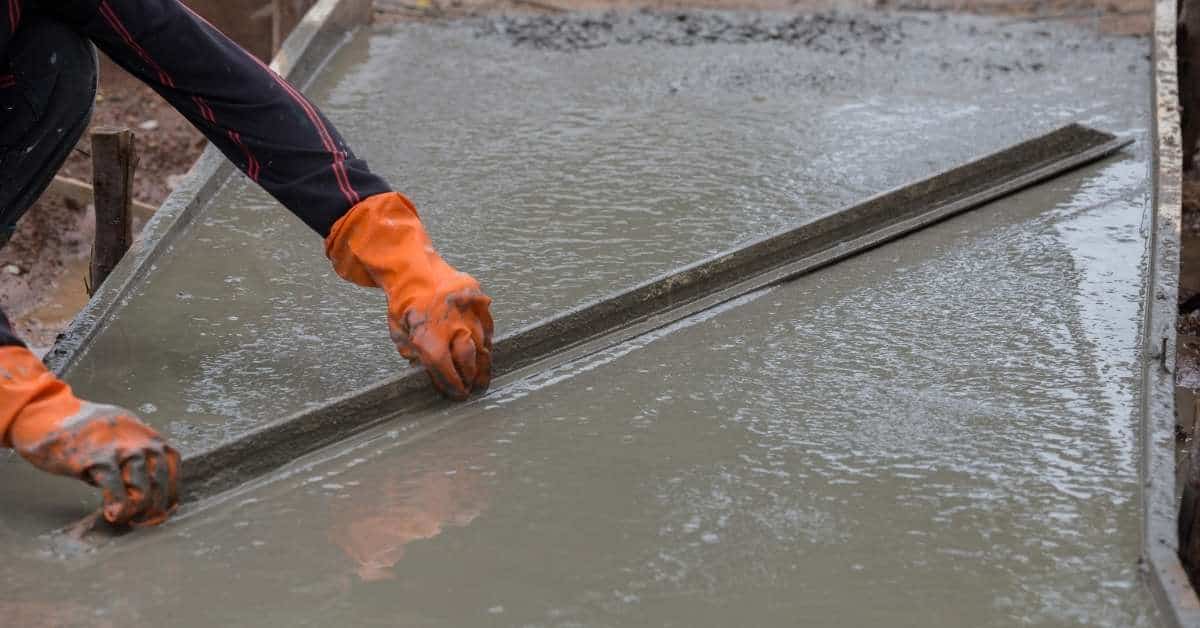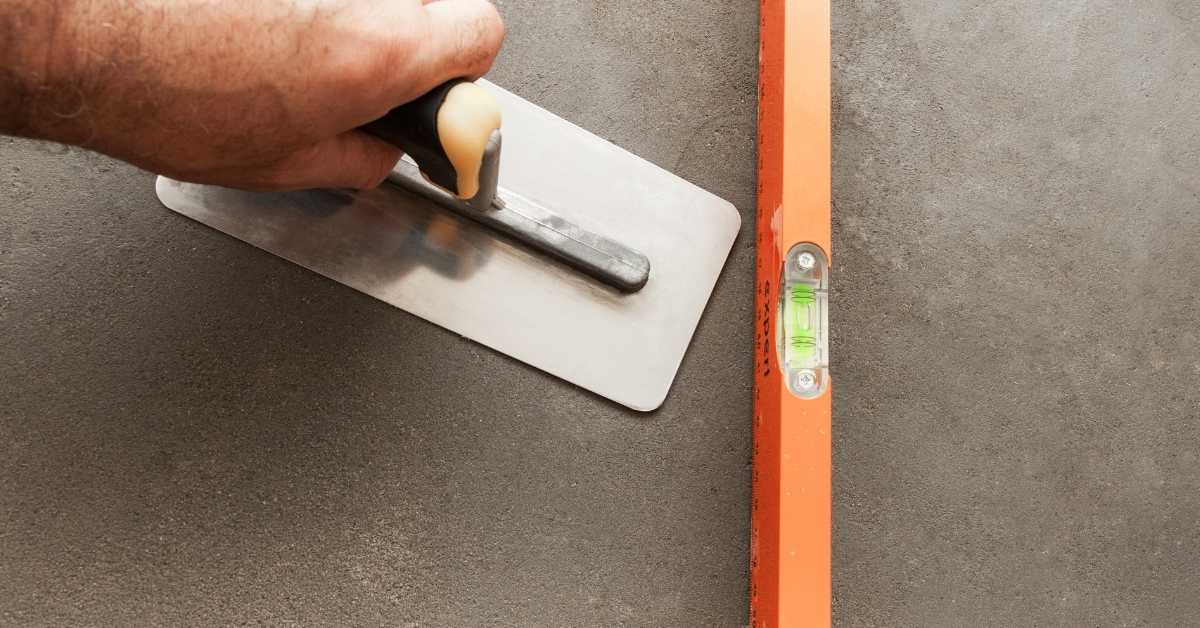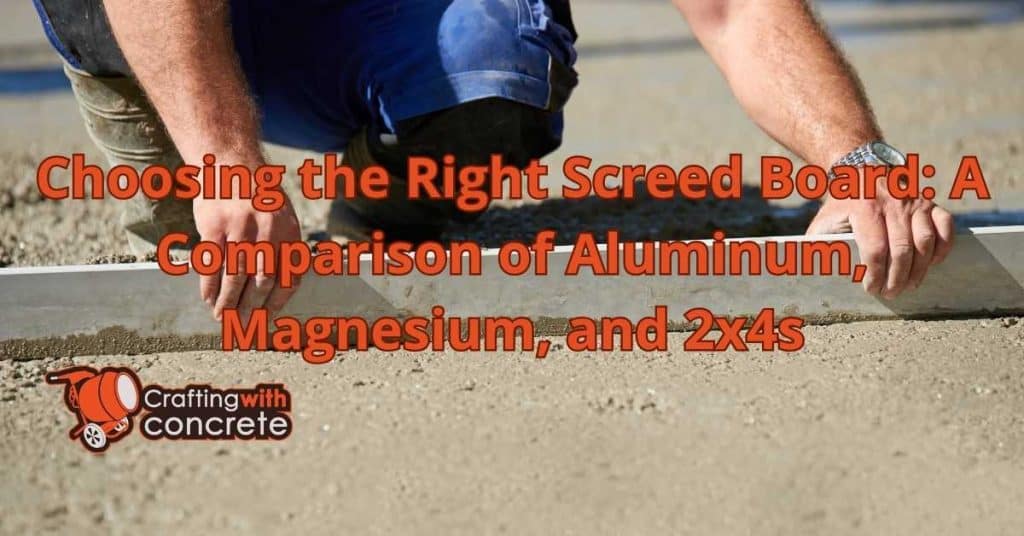Key Takeaways
- Evaluate weight, durability, cost, and flexibility when selecting a screed board for your project.
- Aluminum screed boards are lightweight, corrosion-resistant, and maintain shape, but can be more expensive.
- Magnesium screed boards offer excellent durability and thermal conductivity, making them ideal for large pours.
- Straight 2×4 screed boards are cost-effective and customizable, but ensure they are straight and in good condition for best results.
Introduction
Choosing the right screed board is essential for achieving optimal results in concrete work. The selection process involves comparing various materials, notably aluminum, magnesium, and traditional 2x4s, each offering distinct advantages and disadvantages depending on project requirements.
Factors such as weight, durability, cost, and maintenance should be carefully evaluated to ensure that the chosen screed board aligns with your specific needs. Understanding these characteristics will facilitate a more informed decision, enhancing both the efficiency and quality of your concrete finishing process.
Key Factors for Evaluation
When selecting a screed board, evaluate specific factors that impact performance and usability. Understanding these will help you make an informed decision tailored to your project needs.
- Weight: Consider the weight for handling and transport. Aluminum is lightweight, magnesium is slightly heavier, and 2x4s are the heaviest.
- Durability: Aluminum and magnesium resist warping and cracking, while 2x4s may deteriorate with moisture exposure.
- Cost: Aluminum and magnesium are pricier than 2x4s, but their longevity can justify the investment.
- Flexibility: Aluminum balances rigidity and flexibility; magnesium offers more flex without losing strength, while 2x4s are rigid.
- Surface Finish: Aluminum and magnesium provide smoother finishes, whereas 2x4s may leave a rougher texture.
- Maintenance: Aluminum and magnesium need minimal upkeep, while 2x4s may require treatment to resist rot.
- Length: Choose based on the area size. Boards range from 8 to 16 feet, with longer boards ensuring a consistent finish.
- Temperature Sensitivity: Aluminum expands and contracts more than magnesium or wood, affecting precision in extreme temperatures.
- Environmental Impact: Aluminum and magnesium are recyclable, while wood depends on sustainable sourcing.
- Ease of Use: Lightweight boards like aluminum are easier to handle, while heavier boards require more effort.
- Compatibility with Tools: Ensure compatibility with your tools. Some boards may need specialized handles or attachments.
- Finish Quality: Smoother surfaces from aluminum or magnesium enhance concrete aesthetics, reducing additional finishing.
- Performance in Conditions: Magnesium performs better in damp conditions than wood.
By evaluating these factors, you can select the screed board that best meets your project specifications and performance expectations. Consider the application method. For small, intricate areas, a more flexible screed may be necessary to navigate tight corners effectively.
Professionals recommend using a screed board at least 1.5 inches wider than the concrete pour thickness for optimal leveling. Consider your work environment’s typical conditions. In humid areas, magnesium may be preferable for moisture resistance, while dry climates might not affect aluminum as much.
Moreover, consider the screed board’s lifespan. Aluminum and magnesium can last several years with proper care, while wood may need replacement more frequently due to wear and tear.

Overview of Aluminum Screed Boards
Aluminum screed boards are favored by contractors and DIY enthusiasts for their durability and lightweight design. Let’s delve into their characteristics, benefits, and potential drawbacks in concrete work.
- Resistant to warping: Unlike wood, aluminum maintains its shape, ensuring a consistent, level finish.
- Lightweight: Easy to handle and transport, ideal for job sites.
- Corrosion-resistant: Aluminum does not rust, benefiting longevity, especially in wet environments.
- Proper Handling: Lift from the ends to prevent bending or denting during transport.
- Maintenance: Clean after use to remove concrete residue and maintain surface quality.
- Storage: Store flat and off the ground to prevent warping or moisture damage.
- Temperature Considerations: Plan for expansion and contraction in extreme conditions.
One of the major advantages of aluminum screed boards is their resistance to warping. They maintain their shape over time, ensuring a consistent finish for concrete projects. Their lightweight nature makes them easy to handle and transport, a significant advantage on job sites.
Aluminum’s corrosion resistance is another key benefit. It doesn’t rust, making it ideal for wet or humid environments, contributing to its longevity and repeated use without degradation.
However, consider that aluminum screed boards can be more expensive than wood, which might impact budget-conscious projects. They can also dent if not handled carefully, especially in rough conditions or with heavy equipment.
Aluminum screed boards typically range from 8 to 16 feet in length, offering versatility for various projects. They are usually 1 to 2 inches thick, providing a sturdy tool for leveling concrete. Ensure the board is perfectly straight before use, and use a level to check alignment for a smooth, even surface.
Insights on Magnesium Screed Boards
Magnesium screed boards are popular among contractors for their unique properties and performance benefits. Understanding their characteristics helps determine if they suit your projects.
- Lightweight: Easy to handle and maneuver, reducing fatigue and increasing efficiency during large pours.
- Thermal conductivity: Maintains consistent temperature during curing, crucial for optimal concrete strength.
- Durability: Resists warping and cracking, maintaining a flat, level surface over time.
- Installation Tips: Ensure the subfloor is clean and debris-free for optimal adhesion. Use a laser level to check flatness before pouring to reduce uneven surfaces.
- Maintenance: Regularly inspect for wear or damage, especially in high-traffic areas. Apply a sealant to protect from moisture and enhance durability.
Magnesium boards may be more expensive than traditional options, but their long-term performance and reduced maintenance can offset the initial cost. They’re also environmentally friendly, as they can be recycled.
Best suited for large concrete pours where precision and flatness are critical, magnesium screed boards often provide a smoother finish, making them a preferred choice for. high-quality projects..
Overall, magnesium screed boards offer benefits that enhance the screeding process. Their lightweight design, durability, thermal properties, and environmental advantages make them a strong contender in the market.
Magnesium screed boards perform optimally between 10°C to 30°C (50°F to 86°F). For best results, aim for a screed thickness of 5 to 10 cm (2 to 4 inches), enhancing both strength and thermal efficiency.
Understanding Straight 2×4 Screed Options
When choosing a screed option, straight 2x4s are popular for their availability and ease of use. Let’s explore the features of straight 2×4 screed boards.
Made from softwood like pine or fir, straight 2x4s are easy to find at most lumber yards. Their simplicity makes them ideal for both DIY projects and professional work.
Advantages of Straight 2×4 Screed Boards:
- Cost-Effective: Usually cheaper than aluminum or magnesium options.
- Easy to Handle: Lightweight and manageable for individual users.
- Customizable: Easily cut or modified to fit specific project needs.
When using straight 2x4s as screed boards, ensure they are straight and free of knots. High-quality lumber can greatly affect the screeding process and final surface quality.
Here are some best practices for using straight 2×4 screed boards:.
- Check for Straightness: Lay the board on a flat surface to ensure it’s straight. Avoid warped or bent boards.
- Use a Level: Ensure the screed board is level during setup for an even surface and proper drainage.
- Secure the Board: In larger areas, use stakes or supports to keep the board in place during pouring.
- Inspect for Damage: Regularly check for wear or damage and replace as needed.
- Preparation: Clear the area of debris for a smooth pour.
- Mark Reference Points: Use chalk lines or stakes to mark pour height and boundaries for consistency.
- Work in Sections: Divide large areas into sections to level the concrete before it sets.
- Use Proper Technique: Employ a sawing motion for a smooth finish.
Straight 2x4s typically come in lengths of 8 to 12 feet, offering versatility for different project sizes. With a thickness of 1.5 inches, they provide enough rigidity for effective screeding, suitable for both small and large concrete pours.
For optimal results, aim for a concrete thickness of 4 to 6 inches. This ensures durability and stability in the finished surface.

Comparative Analysis of All Three Materials
This section compares aluminum, magnesium, and straight 2×4 screed boards, focusing on performance, durability, and application suitability. Understanding each material’s pros and cons will guide your choice.
- Weight: Aluminum is light, magnesium is heavier, and 2x4s are the heaviest.
- Durability: Aluminum resists rust; magnesium is durable but moisture-sensitive; 2x4s may warp.
- Cost: Aluminum is priciest, magnesium is mid-range, and 2x4s are cheapest.
- Ease of Use: Aluminum and magnesium are easier to handle than 2x4s.
- Surface Finish: Aluminum and magnesium offer smoother finishes than 2x4s.
- Thermal Conductivity: Aluminum is efficient for heat; magnesium is moderate, 2x4s minimal.
- Environmental Impact: Aluminum is recyclable; magnesium production is energy-intensive; 2x4s rely on sustainable forestry.
- Flexibility: Magnesium flexes slightly; aluminum is rigid; 2x4s can bend under load.
- Maintenance: Aluminum needs little upkeep; magnesium may require sealing; 2x4s need regular checks for rot.
- Compatibility: Aluminum and magnesium suit various concrete mixes; 2x4s offer less leveling precision.
- Temperature Suitability: Aluminum suits high temps, magnesium moderate, 2x4s cooler climates.
Select a screed board based on your project needs. For easy transport and handling, aluminum is ideal. If cost is a concern, consider 2x4s.
Your choice between aluminum, magnesium, and 2x4s depends on project requirements, budget, and preferences. Consider each material’s pros and cons for optimal results.
Aluminum screeds last over 20 years, magnesium 10-15 years, and 2x4s up to 5-10 years, depending on conditions. Aluminum and magnesium excel in precision tasks; 2x4s work for general construction.
Check local availability, as it affects cost and convenience. Aluminum and magnesium may be less common than 2x4s, which are widely available at lumber yards.
Guidance on Selecting Between Options
Choosing the right screed board is crucial for a smooth, level finish in concrete projects. This guide helps you decide between aluminum, magnesium, and straight 2x4s based on your needs.
Consider the following factors when selecting a screed board:.
- Project Scope: Larger projects benefit from aluminum or magnesium for their rigidity. Smaller tasks may be fine with 2x4s.
- Weight: Aluminum and magnesium are lighter than 2x4s, making them easier to handle, especially on large jobs or when working alone.
- Durability: Metal boards resist warping and moisture damage, unlike wood, which can degrade over time.
- Cost: While initially pricier, aluminum and magnesium may save money over time due to their durability.
- Finish Quality: Metal boards typically offer a smoother finish, while wood may need additional sanding.
- Environmental Conditions: In humid areas, metal is preferable for its moisture resistance.
- Ease of Use: Consider the handling and setup of each board type, as some may require special tools or techniques.
- Storage and Maintenance: Metal needs less maintenance than wood, which should be kept dry to prevent rot.
- Personal Preference: Choose based on your experience and comfort with the material.
- Surface Compatibility: Ensure the board suits the surface type, as some materials perform better on uneven surfaces.
- Temperature Resistance: Metal can get hot in sun, while wood may expand or contract with temperature changes.
- Transport and Mobility: Consider how easily you can transport the board, factoring in weight and dimensions.
- Tool Compatibility: Check if specific tools are needed for the board you choose.
Assess your project’s needs and how each material aligns with them to confidently select the best screed board. Aluminum and magnesium boards generally range from 8 to 16 feet, offering flexibility. Standard 2x4s are 8 to 12 feet and may need joining for larger projects.
Evaluating these factors can lead to a successful project and a better experience. In tight spaces, the lightweight nature of aluminum or magnesium is advantageous for maneuverability without compromising performance. Choose a material that suits both practical needs and your comfort level in working conditions.

Conclusion
Aluminum and magnesium boards are often preferred for their lightweight design, resistance to warping, and ability to maintain a smooth finish. However, they come at a higher price point compared to traditional wood options.
One challenge is the potential for aluminum to dent if mishandled, while magnesium boards may require careful maintenance to ensure longevity. Additionally, environmental conditions can affect performance, necessitating careful consideration of materials.
To achieve optimal results, evaluate your specific project needs and choose a screed board that aligns with your requirements. Don’t overlook the importance of proper handling and storage to prolong the life of your chosen board.
Take action today by assessing your project specifications and selecting the most suitable screed board for your concrete work. Your choice will directly influence the final outcome and efficiency of your project.
FAQ
What are the main advantages of using aluminum screed boards?Aluminum screed boards are lightweight, resistant to warping, and corrosion-resistant, making them ideal for various job sites. Their durability ensures a consistent finish, and they require minimal maintenance compared to wood options.
How do magnesium screed boards perform in different conditions?Magnesium screed boards excel in maintaining a consistent temperature during curing, which is crucial for optimal concrete strength. They are lightweight, durable, and resistant to warping, making them suitable for large pours and humid environments.
What should I consider when choosing a screed board?Consider factors such as weight, durability, cost, and flexibility. Each material—aluminum, magnesium, or wood—offers different benefits, so choose one that aligns with the specific needs of your project.
How do straight 2×4 screed boards compare to aluminum and magnesium options?Straight 2×4 screed boards are generally more cost-effective and easy to handle, but they may warp or deteriorate over time, especially in moist conditions. In contrast, aluminum and magnesium boards offer superior durability and performance, albeit at a higher price point.

